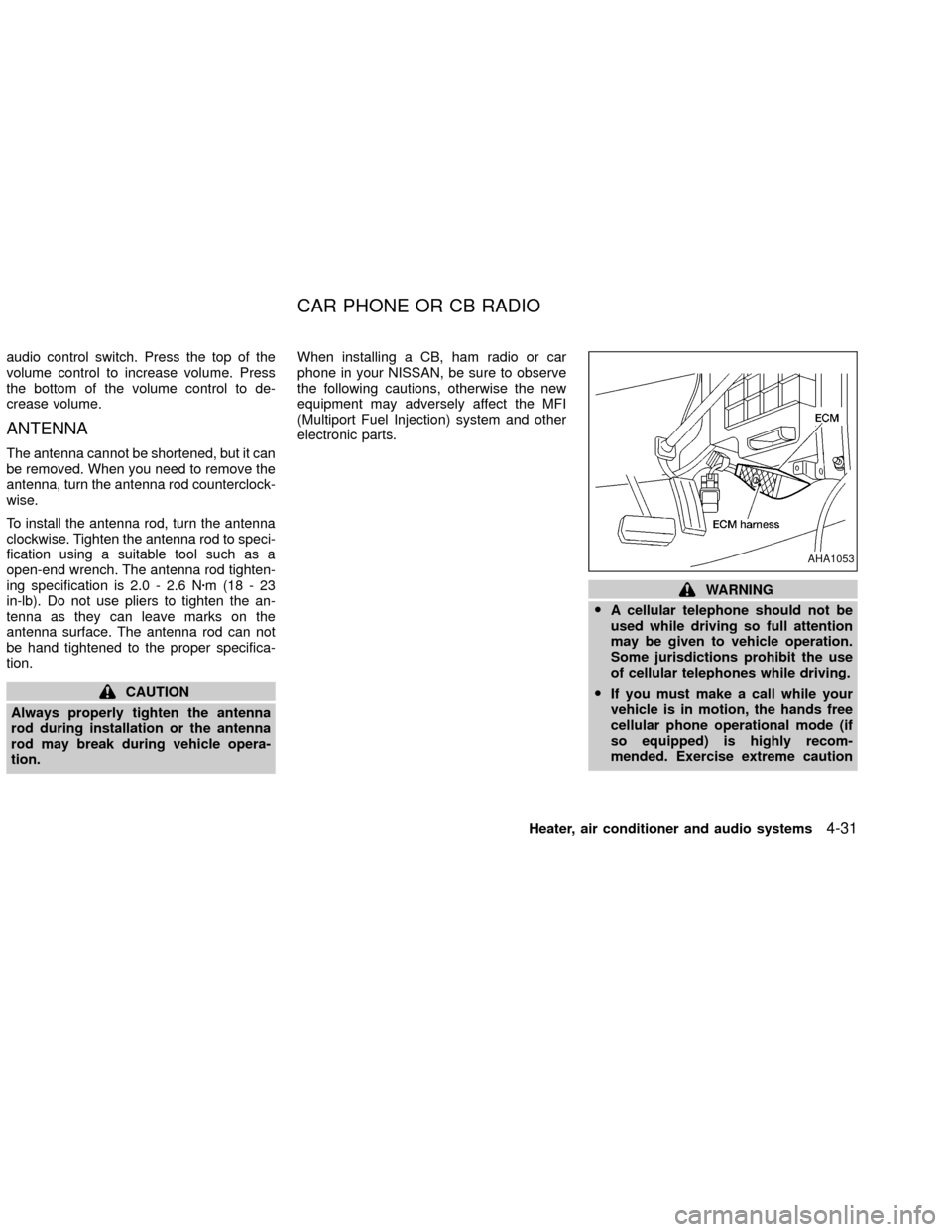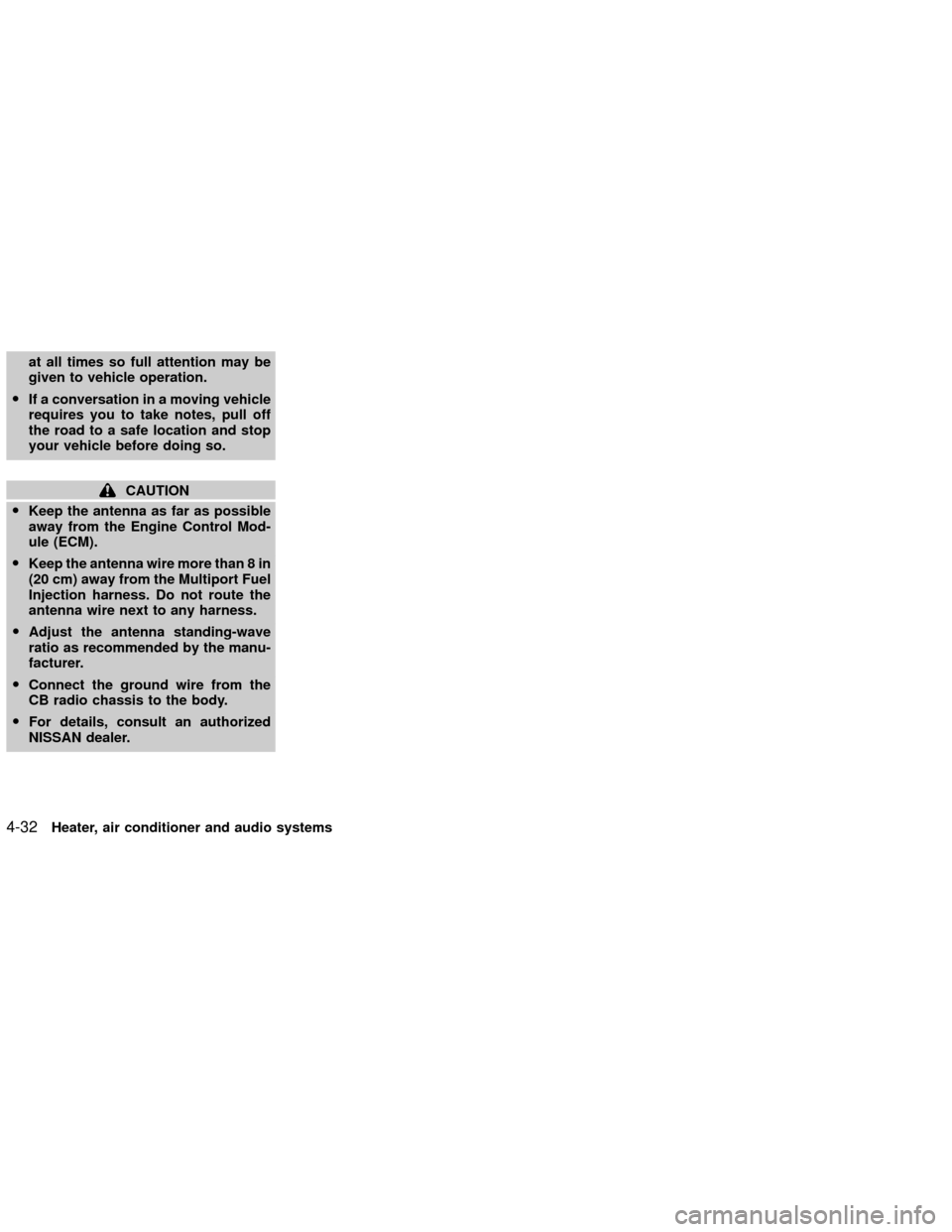2002 NISSAN XTERRA radio antenna
[x] Cancel search: radio antennaPage 100 of 263

4Heater, air conditioner and audio systems
Ventilators ...............................................................4-2
Heater and air conditioner......................................4-3
Controls .............................................................4-3
Heater operation ................................................4-4
Air conditioner operation ...................................4-5
Air flow charts ....................................................4-6
Servicing air conditioner .........................................4-9
Audio system ........................................................4-10
Radio ...............................................................4-10
FM radio reception ..........................................4-10
AM radio reception ..........................................4-10Audio operation precautions ........................... 4-11
FM-AM radio with compact disc (CD)
player (if so equipped).....................................4-13
FM-AM radio with compact disc (CD)
changer (if so equipped) .................................4-18
CD care and cleaning......................................4-29
Steering wheel switch for audio controls
(if so equipped)................................................4-30
Antenna ...........................................................4-31
Car phone or CB radio .........................................4-31
ZX
Page 109 of 263

RADIO
Turn the ignition key to ACC or ON and
press the power on switch to turn on the
radio. If you listen to the radio with the
engine not running, the key should be
turned to the ACC position.
Radio reception is affected by station signal
strength, distance from radio transmitter,
buildings, bridges, mountains and other ex-
ternal influences. Intermittent changes in
reception quality normally are caused by
these external influences.
Using a cellular phone in or near the
vehicle may influence radio reception
quality.
Radio reception
Your NISSAN radio system is equipped with
state-of-the-art electronic circuits to en-
hance radio reception. These circuits are
designed to extend reception range, and to
enhance the quality of that reception.
However there are some general character-
istics of both FM and AM radio signals that
can affect radio reception quality in a mov-
ing vehicle, even when the finest equipment
is used. These characteristics are com-pletely normal in a given reception area,
and do not indicate any malfunction in your
NISSAN radio system.
Reception conditions will constantly change
because of vehicle movement. Buildings,
terrain, signal distance and interference
from other vehicles can work against ideal
reception. Described below are some of the
factors that can affect your radio reception.
FM RADIO RECEPTION
Range: FM range is normally limited to 25 to
30 miles (40 to 48 km), with monaural
(single channel) FM having slightly more
range than stereo FM. External influences
may sometimes interfere with FM station
reception even if the FM station is within 25
miles (40 km). The strength of the FM signal
is directly related to the distance between
the transmitter and receiver. FM signals
follow a line-of-sight path, exhibiting many
of the same characteristics as light. For
example they will reflect off objects.
Fade and drift: As your vehicle moves away
from a station transmitter, the signals will
tend to fade and/or drift.
Static and flutter: During signal interference
from buildings, large hills or due to antennaposition, usually in conjunction with in-
creased distance from the station transmit-
ter, static or flutter can be heard. This can be
reduced by adjusting the treble control
counterclockwise to reduce treble re-
sponse.
Multipath reception: Because of the reflec-
tive characteristics of FM signals, direct and
reflected signals reach the receiver at the
same time. The signals may cancel each
other, resulting in momentary flutter or loss
of sound.
AM RADIO RECEPTION
AM signals, because of their low frequency,
can bend around objects and skip along the
ground. In addition, the signals can be
bounced off the ionosphere and bent back
to earth. Because of these characteristics.
AM signals are also subject to interference
as they travel from transmitter to receiver.
Fading: Occurs while the vehicle is passing
through freeway underpasses or in areas
with many tall buildings. It can also occur for
several seconds during ionospheric turbu-
lence even in areas where no obstacles
exist.
Static: Caused by thunderstorms, electrical
AUDIO SYSTEM
4-10Heater, air conditioner and audio systems
ZX
Page 130 of 263

audio control switch. Press the top of the
volume control to increase volume. Press
the bottom of the volume control to de-
crease volume.
ANTENNA
The antenna cannot be shortened, but it can
be removed. When you need to remove the
antenna, turn the antenna rod counterclock-
wise.
To install the antenna rod, turn the antenna
clockwise. Tighten the antenna rod to speci-
fication using a suitable tool such as a
open-end wrench. The antenna rod tighten-
ing specification is 2.0 - 2.6 Nzm(18-23
in-lb). Do not use pliers to tighten the an-
tenna as they can leave marks on the
antenna surface. The antenna rod can not
be hand tightened to the proper specifica-
tion.
CAUTION
Always properly tighten the antenna
rod during installation or the antenna
rod may break during vehicle opera-
tion.When installing a CB, ham radio or car
phone in your NISSAN, be sure to observe
the following cautions, otherwise the new
equipment may adversely affect the MFI
(Multiport Fuel Injection) system and other
electronic parts.
WARNING
OA cellular telephone should not be
used while driving so full attention
may be given to vehicle operation.
Some jurisdictions prohibit the use
of cellular telephones while driving.
OIf you must make a call while your
vehicle is in motion, the hands free
cellular phone operational mode (if
so equipped) is highly recom-
mended. Exercise extreme caution
AHA1053
CAR PHONE OR CB RADIO
Heater, air conditioner and audio systems4-31
ZX
Page 131 of 263

at all times so full attention may be
given to vehicle operation.
OIf a conversation in a moving vehicle
requires you to take notes, pull off
the road to a safe location and stop
your vehicle before doing so.
CAUTION
OKeep the antenna as far as possible
away from the Engine Control Mod-
ule (ECM).
OKeep the antenna wire more than 8 in
(20 cm) away from the Multiport Fuel
Injection harness. Do not route the
antenna wire next to any harness.
OAdjust the antenna standing-wave
ratio as recommended by the manu-
facturer.
OConnect the ground wire from the
CB radio chassis to the body.
OFor details, consult an authorized
NISSAN dealer.
4-32Heater, air conditioner and audio systems
ZX
Page 256 of 263

10 Index
A
Air bag (See supplemental restraint
system)....................................................... 1-11
Air bag warning light .................................. 1-14
Air cleaner housing filter ............................ 8-23
Air conditioner
Air conditioner operation ........................ 4-5
Air conditioner service ............................ 4-9
Air conditioner specification label ......... 9-14
Air conditioner system refrigerant and
lubrication recommendations.................. 9-8
Heater and air conditioner controls ........ 4-3
Air flow charts .............................................. 4-6
Alarm system (See theft warning) ............. 2-15
Anchor point locations ............................... 1-36
Antenna...................................................... 4-31
Anti-lock brake system (ABS).................... 5-26
Anti-lock brake warning light...................... 2-11
Ashtray (See cigarette lighter and
ashtray) ...................................................... 2-23
Audio system
FM-AM radio with cassette player and
compact disc (CD) player ..................... 4-13
FM-AM radio with compact disc (CD)
changer ................................................. 4-18
Steering wheel audio control switch ..... 4-30
Auto-lock free-running hubs ...................... 5-19Automatic
Automatic power window switch .......... 2-31
Automatic transmission fluid (ATF)....... 8-15
Driving with automatic transmission ....... 5-9
Transmission selector lever lock
release .................................................. 5-12
B
Battery........................................................ 8-19
Battery replacement (See remote keyless
entry system) ............................................... 3-7
Before starting the engine ........................... 5-8
Belts (See drive belts) ............................... 8-20
Brake
Anti-lock brake system (ABS) .............. 5-26
Brake booster ....................................... 8-28
Brake fluid ..................................... 8-17, 9-3
Brake pedal .......................................... 8-27
Brake system ........................................ 5-25
Brake warning light ............................... 2-11
Brake wear indicators ................. 2-14, 8-28
Parking brake check ............................. 8-27
Parking brake operation ....................... 5-14
Break-in schedule ...................................... 5-17
Bulb check/instrument panel ..................... 2-10C
Capacities and recommended fuel/
lubricants...................................................... 9-2
Car phone or CB radio .............................. 4-31
Cargo (See vehicle loading information) ... 9-15
Check engine indicator light
(See malfunction indicator light) ................ 2-14
Child restraint with top tether strap ........... 1-35
Child restraints ........................................... 1-24
Child safety rear door lock .......................... 3-4
Cigarette lighter (accessory) and
ashtray ....................................................... 2-23
Cleaning exterior and interior ...................... 7-2
Clutch
Clutch fluid ............................................ 8-17
Clutch pedal.......................................... 8-29
Cold weather driving .................................. 5-27
Controls
Audio controls (steering wheel) ............ 4-30
Heater and air conditioner controls ........ 4-3
Coolant
Capacities and recommended fuel/
lubricants ................................................ 9-2
Changing engine coolant ...................... 8-11
Checking engine coolant level ............. 8-10
Engine coolant temperature gauge ........ 2-5
Corrosion protection .................................... 7-5
ZX